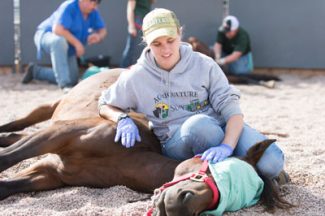And then, for the stallions, castration. The procedure, like neutering a male dog, prevents unwanted offspring and calms aggressive behavior. The surgery is thus required for all stallions that arrive at Harmony Equine Center.
“Our biggest goal is to do the best thing for the horse,” said Dr. Luke Bass, head of Colorado State’s Equine Field Service and leader of the daylong surgical clinic. “This is also giving these students important skills to use when they get out into practice. It’s making them better veterinarians.”
 Dr. Luke Bass, head of the CSU Equine Field Service, helps a horse stand up after surgery. • Photo by Bill Cotton/Colorado State University Photography
Dr. Luke Bass, head of the CSU Equine Field Service, helps a horse stand up after surgery. • Photo by Bill Cotton/Colorado State University Photography
In about six hours, the CSU veterinary team would castrate 23 rescued horses. They worked on three horses at a time, the students taking turns handling, administering anesthesia and performing surgery.
As he talked, Bass oversaw a student at work, cutting and clamping with an emasculator. “Another brain surgery,” he remarked lightly, referring to the animal’s newly acquired ability to focus on something more than procreation.
Meanwhile, in another team of students and instructors, Marley checked her watch, eyeing the time her patient had been under. Miller, her partner, investigated the gelding’s 4-inch incision, looking for the source of a slow blood leak. Dr. Chuck Whitmer, a veterinary intern, sat on the ground holding a hind leg out of the way with a lead rope wrapped around the horse’s hock.
Finding, clipping and clamping the leaking vessel would avoid hemorrhage and allow for speedy healing. Soon, Miller, wearing surgical gloves, found the source of the leak.
“If you need to, you can ligate that little guy,” said Dr. Elsbeth Swain, another veterinarian with the CSU Equine Field Service. She observed closely as Miller wound ligature around the leaking vessel and prepared to clip off the end.
“As proximal to the body as you can get,” she coached, as Miller then stanched bleeding with a hemostat. He dabbed with gauze, noting that blood flow had stopped.
“I’m OK with it,” Miller said, nodding to his instructor.
“If you’re happy, I’m happy,” Swain replied. “This was a good one to triple troubleshoot.”
Castration incisions typically are not stitched in horses, she explained, as veterinarians have found that complete healing occurs quicker without sutures.
Waiting for her patient to rouse from anesthesia, Marley noted the value of the surgical clinic for veterinary students.
“It’s an excellent experience because we really get to be the veterinarians, working through problems as we see them, but Dr. Bass and Dr. Swain are right there to help if we need them,” she said. “In May, when we graduate, this is going to be us. So this gives you so much more confidence that you can perform the surgery, probably with just the horse and your client in the field.”
Click page 3 to continue …


